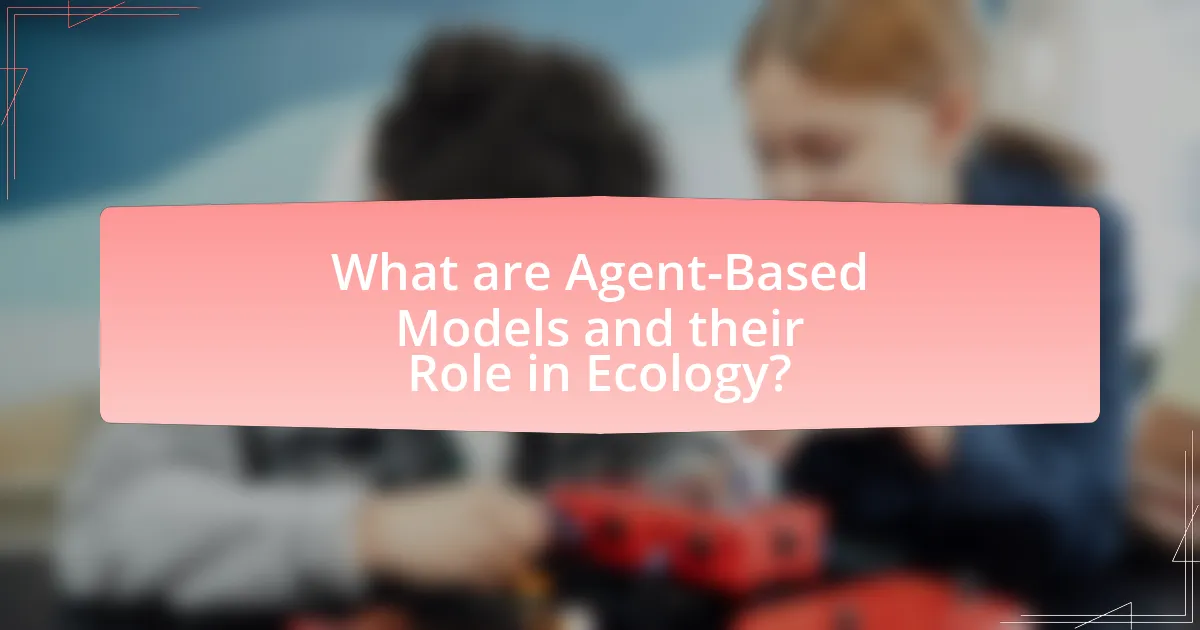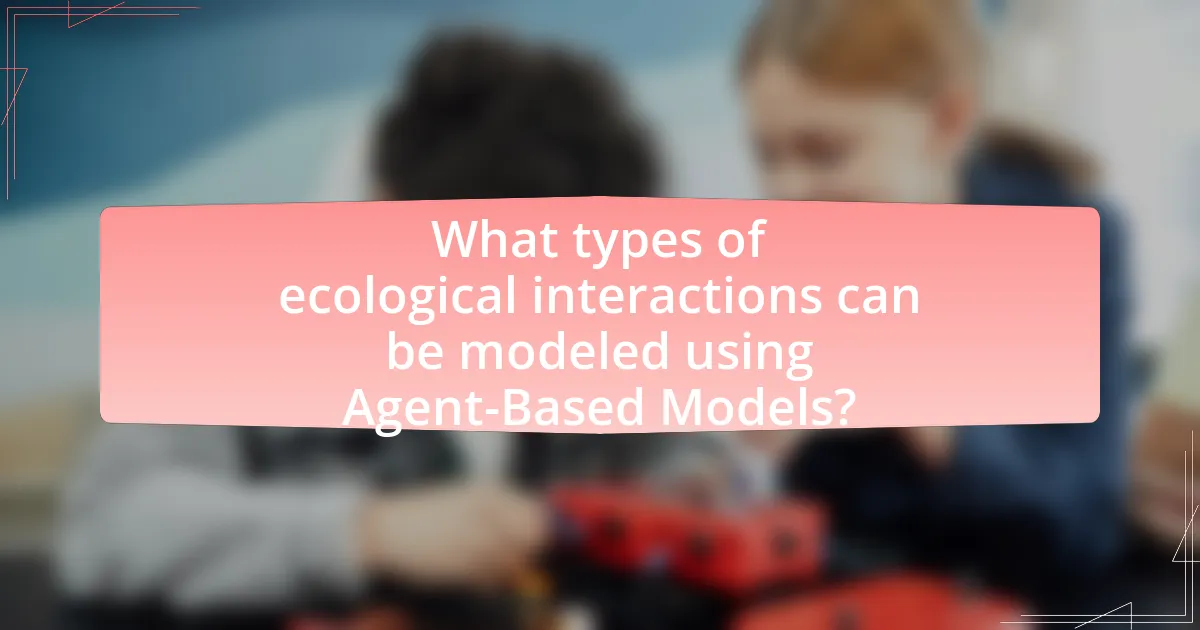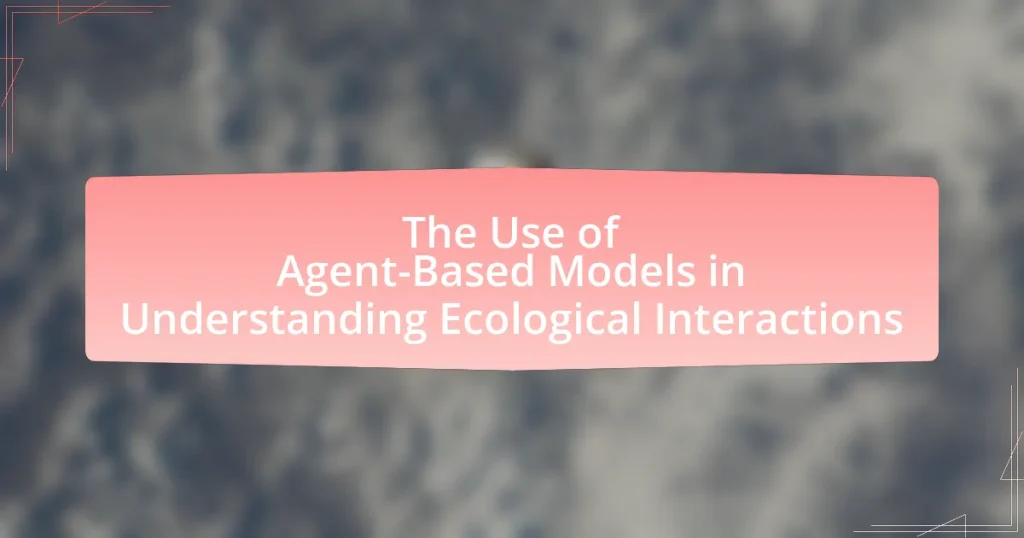Agent-Based Models (ABMs) are computational simulations that represent individual entities and their interactions within ecological systems. This article explores the role of ABMs in understanding complex ecological interactions, including species behavior, population dynamics, and ecosystem processes. Key components of ABMs, such as agents, environment, and rules of interaction, are discussed, along with their applications in modeling predator-prey dynamics, competition among species, and the spread of invasive species. The article also highlights the importance of ABMs in informing conservation strategies and the challenges researchers face in their implementation, emphasizing best practices for enhancing model accuracy and reliability.

What are Agent-Based Models and their Role in Ecology?
Agent-Based Models (ABMs) are computational simulations that represent individual entities, or agents, and their interactions within a defined environment. In ecology, ABMs are utilized to study complex ecological interactions, such as species behavior, population dynamics, and ecosystem processes. These models allow researchers to simulate scenarios that reflect real-world ecological systems, enabling the exploration of how individual behaviors influence collective outcomes. For instance, ABMs have been applied to understand predator-prey dynamics, habitat selection, and the spread of invasive species, demonstrating their effectiveness in capturing the nuances of ecological interactions.
How do Agent-Based Models simulate ecological interactions?
Agent-Based Models (ABMs) simulate ecological interactions by representing individual organisms as autonomous agents that interact with each other and their environment based on defined rules. These models allow researchers to observe emergent behaviors and complex dynamics within ecosystems, such as predator-prey relationships and resource competition. For instance, ABMs can incorporate factors like reproduction, movement, and resource availability, enabling the simulation of population dynamics over time. Studies, such as those by Railsback and Grimm (2012) in “Agent-Based Modeling for Ecological Research,” demonstrate that ABMs effectively capture the nuances of ecological interactions, providing insights into how individual behaviors influence overall ecosystem health and stability.
What are the key components of Agent-Based Models in ecology?
The key components of Agent-Based Models (ABMs) in ecology include agents, environment, rules of interaction, and time. Agents represent individual entities, such as animals or plants, that exhibit behaviors based on specific rules. The environment provides the spatial and temporal context in which these agents operate, influencing their interactions and behaviors. Rules of interaction define how agents communicate and respond to one another and their environment, often incorporating biological and ecological principles. Time is a critical component, as ABMs simulate processes over discrete time steps, allowing for the observation of dynamic ecological interactions and changes. These components work together to create a framework for understanding complex ecological systems and predicting outcomes based on agent behaviors and interactions.
How do agents behave within these models?
Agents within agent-based models behave as autonomous entities that interact with one another and their environment based on predefined rules and behaviors. These interactions can lead to complex system dynamics, where individual actions aggregate to produce emergent phenomena at the population level. For instance, in ecological models, agents may represent species that adapt their foraging strategies based on resource availability, which can be quantitatively analyzed to understand population dynamics and ecosystem stability. This behavior is validated by studies such as “Agent-Based Modeling of Ecological Systems” by Railsback and Grimm, which demonstrate how agent interactions can simulate real-world ecological processes effectively.
Why are Agent-Based Models important for understanding ecosystems?
Agent-Based Models (ABMs) are important for understanding ecosystems because they simulate the interactions of individual agents, such as species or environmental factors, to reveal complex ecological dynamics. These models allow researchers to explore how local behaviors of agents lead to emergent phenomena at the ecosystem level, providing insights into population dynamics, resource competition, and species interactions. For instance, studies have shown that ABMs can effectively model predator-prey relationships, demonstrating how changes in one species can impact the entire ecosystem. This capability to capture non-linear interactions and feedback loops makes ABMs a powerful tool for predicting ecological outcomes and informing conservation strategies.
What insights can be gained from using Agent-Based Models?
Agent-Based Models (ABMs) provide insights into complex ecological interactions by simulating the behaviors and interactions of individual agents within an environment. These models allow researchers to observe emergent phenomena that arise from local interactions, such as population dynamics, resource competition, and predator-prey relationships. For instance, ABMs have been used to study the spread of invasive species, revealing how individual behaviors can lead to large-scale ecological impacts. Additionally, ABMs facilitate the exploration of various scenarios and management strategies, enabling scientists to predict outcomes under different environmental conditions and policy interventions. This predictive capability is supported by empirical data, such as the successful application of ABMs in understanding the dynamics of fish populations in marine ecosystems, as demonstrated in studies published in journals like Ecological Modelling.
How do these models compare to traditional ecological modeling approaches?
Agent-based models (ABMs) differ from traditional ecological modeling approaches by emphasizing individual-level interactions and behaviors rather than aggregate population dynamics. Traditional models often rely on differential equations to represent population changes, which can overlook the complexities of individual interactions and heterogeneity within populations. In contrast, ABMs simulate the actions and interactions of autonomous agents, allowing for the exploration of emergent phenomena and adaptive behaviors in ecosystems. This approach has been validated in studies such as “Agent-Based Modeling of Ecological Systems” by Railsback and Grimm, which demonstrates that ABMs can capture dynamics that traditional models may miss, such as the effects of individual variability on population outcomes.

What types of ecological interactions can be modeled using Agent-Based Models?
Agent-Based Models (ABMs) can effectively model various types of ecological interactions, including predation, competition, mutualism, and disease spread. These models simulate individual agents, such as animals or plants, and their interactions within an ecosystem, allowing researchers to observe emergent behaviors and patterns. For instance, ABMs have been used to study predator-prey dynamics, where the behaviors of both predators and prey are modeled to understand population fluctuations. Additionally, competition for resources among species can be analyzed through ABMs, revealing how different strategies affect survival and reproduction. Mutualistic relationships, such as those between pollinators and flowering plants, can also be explored, demonstrating the benefits of cooperation in ecosystems. Furthermore, ABMs are instrumental in modeling the spread of diseases within populations, providing insights into transmission dynamics and potential control measures.
How do Agent-Based Models represent predator-prey dynamics?
Agent-Based Models (ABMs) represent predator-prey dynamics by simulating individual agents, such as predators and prey, that interact within a defined environment. These models allow for the observation of complex behaviors and interactions, capturing the effects of individual decision-making and movement patterns on population dynamics. For instance, ABMs can incorporate rules governing hunting strategies of predators and escape behaviors of prey, leading to emergent phenomena such as population oscillations and spatial distribution changes. Research has shown that ABMs effectively illustrate these dynamics, as evidenced by studies like “Agent-Based Modeling of Predator-Prey Interactions” by Railsback and Grimm, which demonstrate how varying parameters can influence stability and coexistence in ecosystems.
What factors influence predator-prey interactions in these models?
Predator-prey interactions in agent-based models are influenced by factors such as resource availability, reproductive rates, and environmental conditions. Resource availability directly affects the population dynamics of both predators and prey; for instance, a decrease in prey availability can lead to a decline in predator populations due to starvation. Reproductive rates determine how quickly populations can recover after fluctuations, impacting the stability of the interaction. Environmental conditions, including habitat structure and climate, also play a crucial role by affecting the movement and behavior of both predators and prey, thereby influencing their interactions. These factors are supported by empirical studies that demonstrate how changes in resource levels and environmental variables can lead to significant shifts in predator-prey dynamics, as seen in various ecosystems.
How can these models predict changes in population dynamics?
Agent-based models can predict changes in population dynamics by simulating individual behaviors and interactions within a population. These models incorporate rules governing the actions of agents, such as reproduction, movement, and resource consumption, allowing researchers to observe emergent patterns over time. For instance, studies have shown that agent-based models can effectively replicate real-world phenomena, such as the spread of diseases or the impact of environmental changes on species populations, by adjusting parameters to reflect different scenarios. This capability is supported by empirical data, such as the work of Railsback and Grimm (2012) in “Agent-Based Modeling for Natural Resource Management,” which demonstrates how these models can provide insights into population trends and dynamics under varying conditions.
What role do Agent-Based Models play in studying competition among species?
Agent-Based Models (ABMs) play a crucial role in studying competition among species by simulating individual interactions and behaviors within ecological systems. These models allow researchers to explore how species compete for resources, adapt to environmental changes, and influence each other’s population dynamics. For instance, ABMs can incorporate specific traits such as foraging strategies and reproductive rates, enabling the examination of how these traits affect competitive outcomes. Studies have shown that ABMs can replicate complex ecological phenomena, such as the emergence of stable coexistence or competitive exclusion, providing insights into the mechanisms driving biodiversity.
How do these models illustrate resource allocation among competing species?
Agent-based models illustrate resource allocation among competing species by simulating individual interactions and behaviors that affect resource distribution. These models allow researchers to observe how species compete for limited resources, such as food and habitat, and how these interactions influence population dynamics and community structure. For example, studies using agent-based models have shown that species with different foraging strategies can coexist by partitioning resources, thereby demonstrating the impact of behavioral adaptations on resource allocation. This approach provides concrete insights into ecological processes, as evidenced by research published in “Ecological Modelling” by Railsback and Grimm, which highlights how agent-based simulations can reveal complex interactions that traditional models may overlook.
What are the implications of competition modeling for biodiversity conservation?
Competition modeling has significant implications for biodiversity conservation by providing insights into species interactions and ecosystem dynamics. These models help predict how species compete for resources, which can inform conservation strategies aimed at maintaining or restoring biodiversity. For instance, research has shown that understanding competitive relationships can guide habitat management and species reintroduction efforts, ensuring that conservation actions support coexistence rather than exacerbate competition. Additionally, competition modeling can identify keystone species whose preservation is crucial for maintaining ecosystem balance, thereby enhancing conservation outcomes.

How can Agent-Based Models be applied in real-world ecological research?
Agent-Based Models (ABMs) can be applied in real-world ecological research to simulate and analyze the interactions of individual organisms within their environments. These models allow researchers to explore complex ecological dynamics, such as predator-prey relationships, species competition, and the impact of environmental changes on biodiversity. For instance, a study by Grimm et al. (2005) demonstrated how ABMs can effectively model the foraging behavior of animals, providing insights into population dynamics and resource use. By incorporating individual behaviors and interactions, ABMs facilitate a deeper understanding of ecological processes and can inform conservation strategies and management practices.
What are some case studies demonstrating the effectiveness of Agent-Based Models?
Agent-Based Models (ABMs) have been effectively demonstrated in various case studies, particularly in ecological interactions. One notable case study is the work by Grimm et al. (2005) titled “Pattern-Oriented Modeling of Agent-Based Complex Systems: Lessons from Ecology,” published in the journal “Complexity.” This study illustrates how ABMs can simulate predator-prey dynamics, revealing insights into population fluctuations and ecosystem stability.
Another significant case study is the research conducted by Railsback and Harvey (2015) in “Agent-Based Modeling for Natural Resource Management: A Case Study of the California Delta,” published in “Environmental Modelling & Software.” This study showcases the application of ABMs in managing water resources and understanding the impact of human activities on aquatic ecosystems.
Additionally, the study by An et al. (2015) titled “Agent-Based Modeling of Land Use Change: A Case Study of the Greater Toronto Area,” published in “Computers, Environment and Urban Systems,” demonstrates how ABMs can effectively model land-use changes and their ecological consequences, providing valuable insights for urban planning and environmental management.
These case studies collectively highlight the versatility and effectiveness of Agent-Based Models in understanding complex ecological interactions and informing management strategies.
How have these models been used to inform conservation strategies?
Agent-based models (ABMs) have been utilized to inform conservation strategies by simulating the interactions of individual organisms within ecosystems, allowing researchers to predict the outcomes of various conservation interventions. For instance, ABMs have been applied to assess the impact of habitat restoration on species populations, demonstrating how changes in environmental conditions can influence species behavior and survival rates. A study by An et al. (2020) in “Ecological Modelling” highlighted that ABMs can effectively model the effects of climate change on biodiversity, providing insights that guide policy decisions for habitat protection. These models enable conservationists to visualize potential scenarios and make data-driven decisions, ultimately enhancing the effectiveness of conservation efforts.
What lessons have been learned from applying Agent-Based Models in field studies?
Applying Agent-Based Models (ABMs) in field studies has revealed several key lessons, primarily highlighting the importance of model calibration and validation against real-world data. These models have demonstrated that individual behaviors and interactions can significantly influence ecological outcomes, emphasizing the need for accurate representation of agent characteristics and environmental conditions. For instance, research by Grimm et al. (2005) in “Pattern-Oriented Modeling of Agent-Based Complex Systems” illustrates how ABMs can effectively capture emergent phenomena in ecological systems, validating their utility in predicting population dynamics and species interactions. Furthermore, field studies have shown that ABMs can facilitate adaptive management strategies by simulating various scenarios and assessing potential ecological impacts, thereby informing conservation efforts.
What challenges do researchers face when using Agent-Based Models in ecology?
Researchers face several challenges when using Agent-Based Models (ABMs) in ecology, including model complexity, data requirements, and validation issues. The complexity of ABMs can lead to difficulties in understanding and interpreting model behavior, as the interactions between agents can produce emergent phenomena that are not easily predictable. Additionally, ABMs often require extensive and high-quality data to accurately represent ecological systems, which can be difficult to obtain. Validation of ABMs poses another challenge, as researchers must ensure that the model outputs align with real-world observations, necessitating rigorous testing and comparison against empirical data. These challenges highlight the need for careful design and implementation of ABMs in ecological research.
How can data limitations affect the outcomes of Agent-Based Models?
Data limitations can significantly skew the outcomes of Agent-Based Models (ABMs) by leading to inaccurate representations of ecological interactions. When the input data is incomplete or of low quality, the agents within the model may not behave as they would in real-world scenarios, resulting in misleading predictions. For instance, if demographic data on species populations is outdated or missing, the model may fail to capture critical dynamics such as competition or predation, which are essential for understanding ecosystem functions. Research has shown that models relying on poor data can produce results that deviate substantially from observed ecological patterns, undermining their utility in decision-making processes related to conservation and resource management.
What strategies can be employed to improve model accuracy and reliability?
To improve model accuracy and reliability in agent-based models for ecological interactions, employing strategies such as parameter tuning, validation against empirical data, and sensitivity analysis is essential. Parameter tuning involves adjusting model parameters to better reflect real-world conditions, which can enhance the model’s predictive capabilities. Validation against empirical data ensures that the model’s outputs align with observed ecological phenomena, thereby confirming its reliability. Sensitivity analysis identifies how variations in model parameters affect outcomes, allowing researchers to understand the robustness of their models. These strategies collectively contribute to more accurate and reliable agent-based models in ecological research.
What best practices should researchers follow when implementing Agent-Based Models in ecological studies?
Researchers should follow several best practices when implementing Agent-Based Models (ABMs) in ecological studies. First, they must clearly define the agents and their behaviors, ensuring that these accurately represent the ecological processes being studied. This involves specifying the rules governing agent interactions and environmental influences, which enhances model realism and validity.
Second, researchers should conduct thorough sensitivity analyses to understand how variations in model parameters affect outcomes. This practice helps identify critical parameters and improves the robustness of the model’s predictions.
Third, validation of the model against empirical data is essential. Researchers should compare model outputs with real-world observations to ensure that the model accurately reflects ecological dynamics.
Additionally, documenting the modeling process, including assumptions and limitations, is crucial for transparency and reproducibility. This allows other researchers to understand the model’s context and applicability.
Finally, engaging with interdisciplinary teams can provide diverse perspectives and expertise, enriching the model’s development and application. These best practices collectively enhance the reliability and utility of ABMs in ecological research.


